Fa’alifu Fa’i – Introduction
Here on Oahu, there is no shortage of bananas. Not only do we have multiple banana plants, our friends and neighbors do also. This creates a situation similar to people who grow zucchini. You never know when someone is going to anonymously drop an entire stalk of bananas on your porch.
Now I love Polynesian food more than most anything – but there are times I simply have too many bananas to process. My first “go-to” is Peggy Hanneman’s Tropical Banana Bread recipe. But when it’s a bunch of very green bananas, there is another amazing, not to mention ridiculously easy recipe, called Fa’alifu Fa’i.
Why this is a starch, not a sweet dish
The thing many non-Polynesians may not know is that a green banana is actually 70 – 80% resistant starch, providing a dietary fiber linked to several health benefits. Once a banana ripens, that starch turns into simple sugars (sucrose, glucose, and fructose), leaving it with only 1% starch.
The problem is that a green banana is virtually inedible in its raw form. Not to worry! Ever resourceful, Polynesians have learned how to utilize the green banana in delicious ways, including this wonderful recipe for Fa’alifu Fa’i.
What type of bananas work best?
The type of banana that you use will make a big difference. Most people from the Continental United States and Canada are used to Cavendish bananas, which start out firm and heads to soft and brown soon after ripening. Remembering that this recipe is for very green bananas only, you will still find that the Cavendish are going to cook fairly quickly. If this is your banana, do not exceed the recommended cooking time until you’ve tried this recipe once.
If you have access to Plantains (the type that never really ripen), then your cooking time is definitely longer. In the middle are the delicious apple banana or ice cream banana, found here on the islands of Hawaii. These strains tend to settle into the nice, just ripe stage for a longer time, and never turn that blackish brown common with the Cavendish strain. Long story short – the type of banana will definitely affect the amount of time you cook them.
Easiest recipe ever!
My husband is the mastermind for our trying this recipe. He hates to throw out bananas. After years of having Fa’alifu Fa’i served to us, he thought it was time to try cooking it ourselves. We were delighted to discover how easy it is.
Since we were “going in blind”, so to speak, we decided to view the various recipes out on the internet. We settled on learning how to make it through this fun video by one of our favorite people, Creasepaul (Fune) Tofa, from the Polynesian Cultural Center. In this video, Fune uses strictly traditional methods. We simply converted our preparation to pālagi (as in not Samoan) cooking methods.
Fune posted this gem on the Fune YouTube channel. These videos are full of Samoan recipes, weaving, culture and that amazing Samoan sense of humor. I highly recommend you follow it.
HOW TO MAKE FA’ALIFU FA’I
I’m giving you a prewarning here. I personally never developed a taste for Fa’alifu Fa’i in its traditional preparation. I hope not to offend anyone, but for those of you who tried this dish and found it too ‘chewy’, I will provide an alternative that might be more palatable to Western taste buds.
Fa’alifu Fa’i Equipment
Mixing bowl
8-12 quart pot with lid
Sturdy butter knife (or a hibiscus stick – your call)
Wooden cooking spoon or spatula
Fa’alifu Fa’i Ingredients
8 green bananas
1 can organic coconut milk
Add about 1 – 2 tsp sea salt (to taste)
Chopped onions.
You might prefer fresh garlic or yellow onion, along with other seasonings (you will notice that I also added some lemongrass for flavor). It’s your dish and your choice, but try this simple version first. You’ll be surprised how flavorful it is.
Other herbs and spices can be added. I included lemon grass.
IMPORTANT! The cooking phases of this recipe go fast and furious. Have all ingredients and equipment ready to go so that you can concentrate on working through the steps quickly.
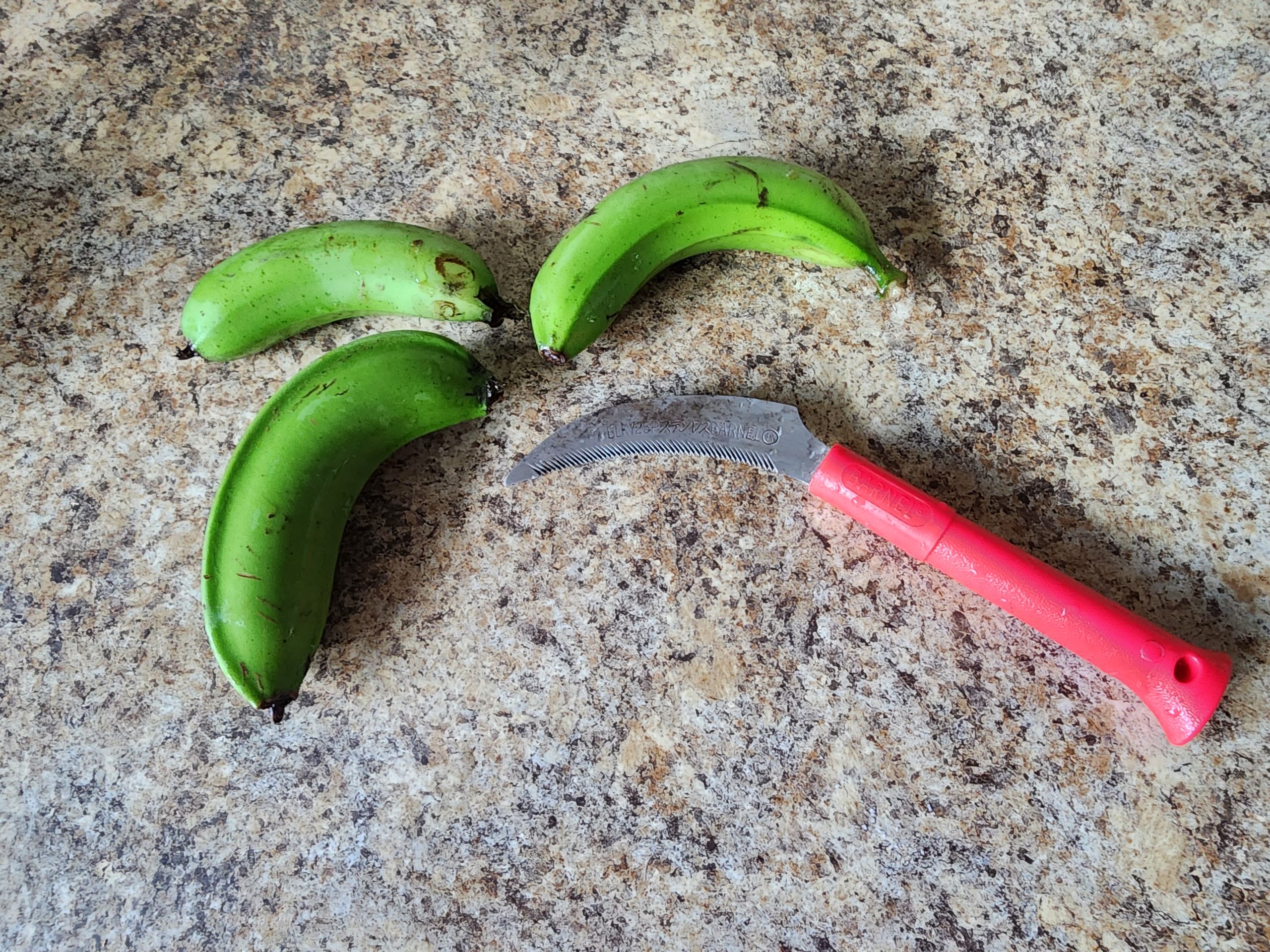
This recipe calls for 8 green bananas. Bananas should be medium to large and very green.
Fa’alifu Fa’i Recipe
Peeling Bananas
This is the hardest part of the recipe, but it isn’t difficult at all once you get a feel for it. Samoans do this with a hibiscus stick about the size of a drumstick with one end whittled down to a flattened ‘scoop’.
Not to worry if you’re fresh out of sticks, simply take your heavy-duty butterknife and score the skin lengthwise 4 times (do NOT use a sharp knife, unless you want a trip to the hospital for stitches).
Take the back of that knife and begin peeling off the skin. This is not going to be the same as peeling a yellow banana. This will take some work.
You want to slide the knife between the peel and the fruit. The peel will most likely come off in chunks. Be patient, use a firm hand with the knife, but try not to butcher the fruit inside. Steady, even strokes should do the trick!
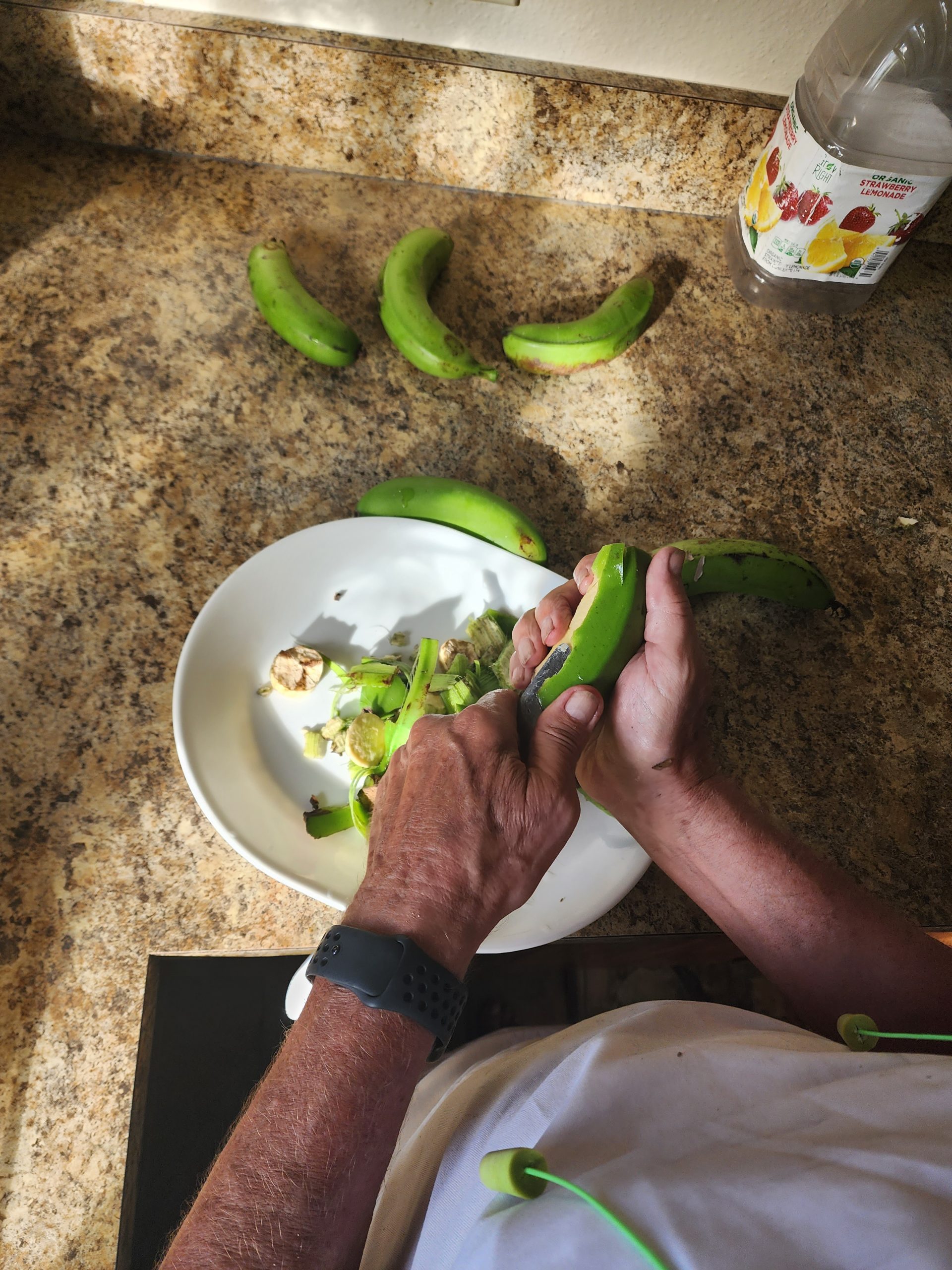
How to peel a green banana with a butter knife.
Now using the sharper side of the knife, scrape off any leftover peel.
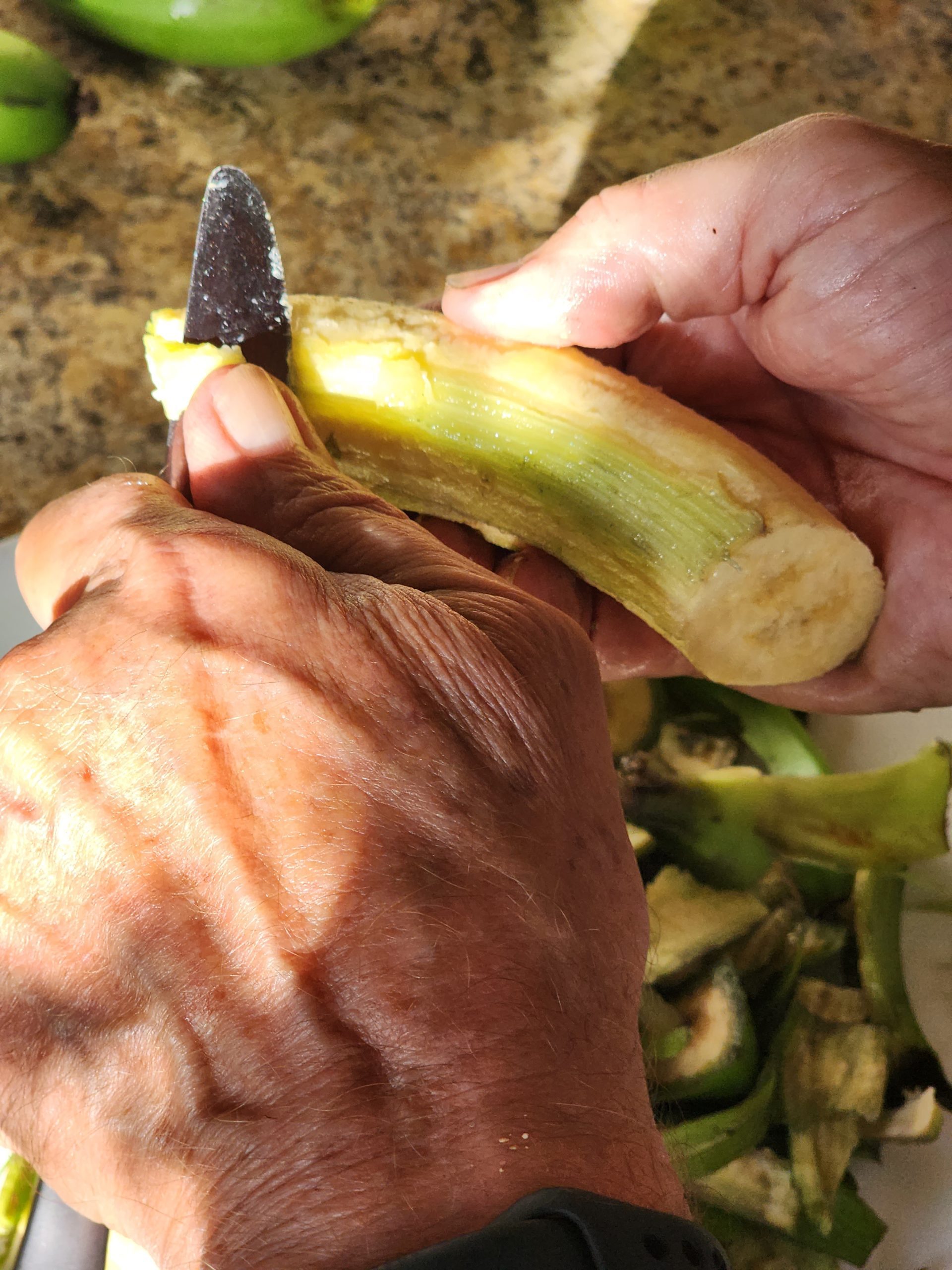
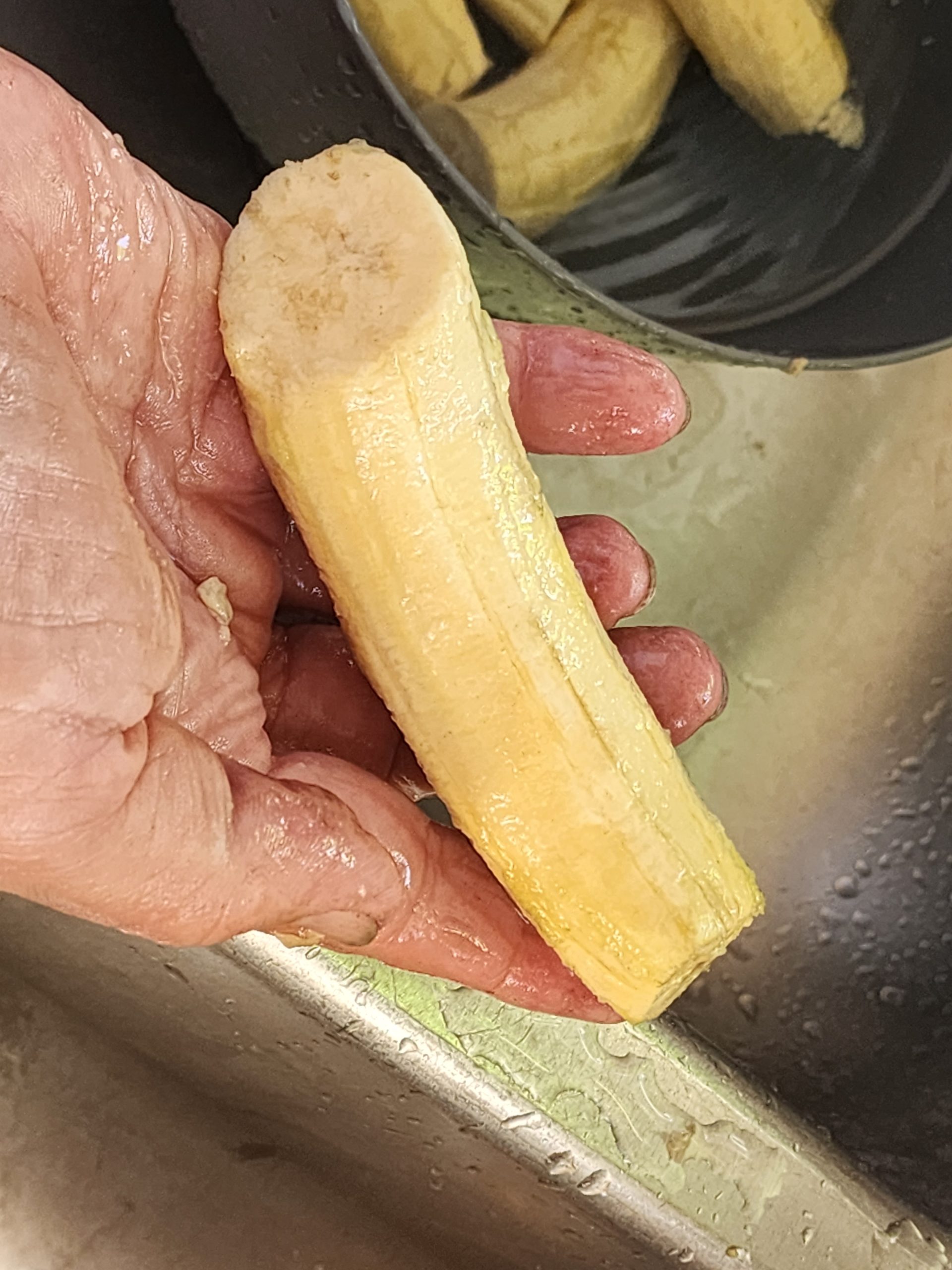
Boil the bananas
Place enough water into a saucepan that will cover the bananas. Get the water boiling before placing the bananas in the water. Once it is at a full boil, reduce the heat to medium / medium low (depending on your stove), add the bananas and cover with a lid, cooking them on a medium boil for approximately 5 minutes.
NOTE: Do not overcook at this point. Respect the time allotted. If you like your bananas less firm, the next step is when to address that. Not now.
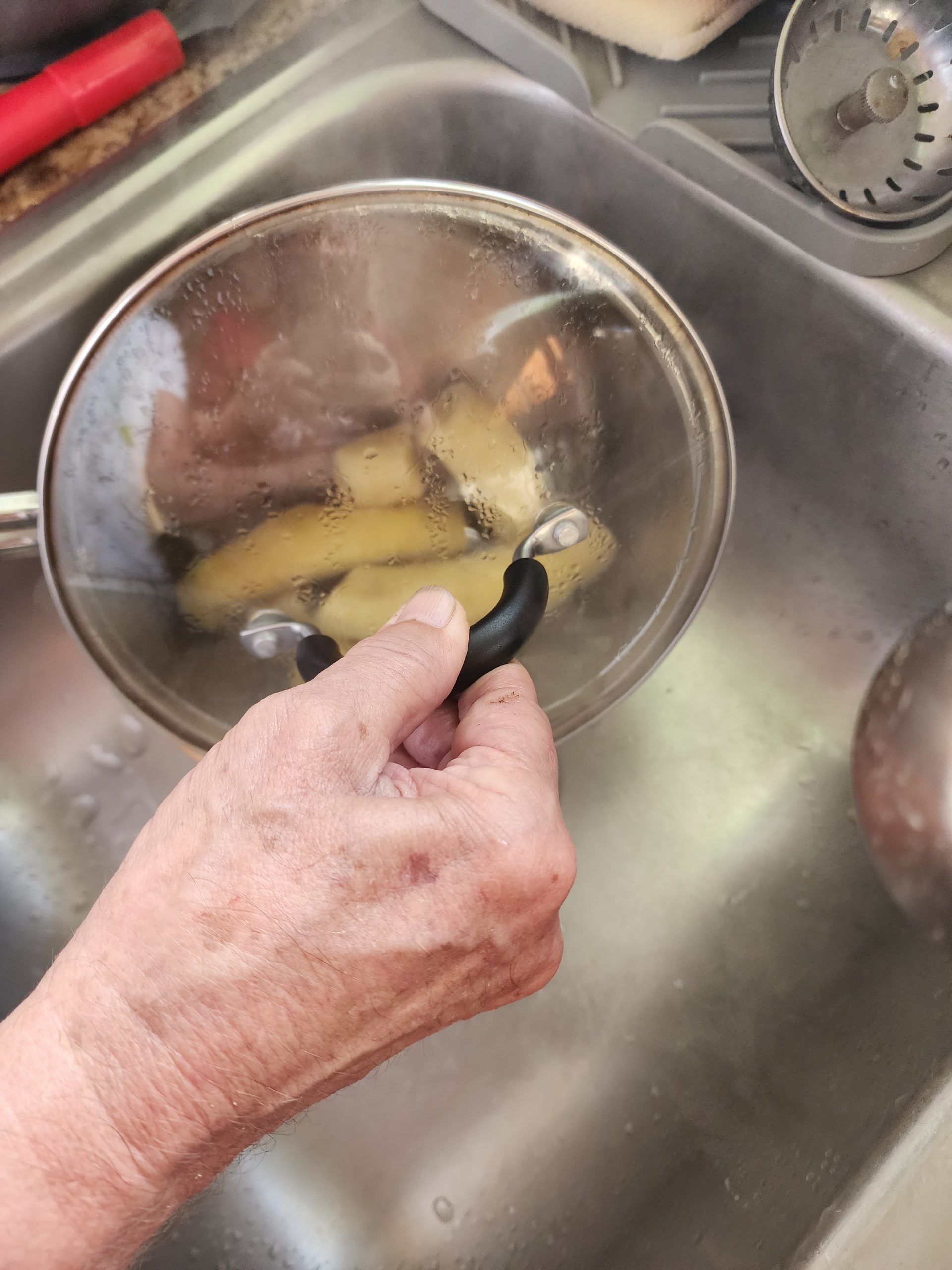
Drain the bananas well.
Pour the water out and place the bananas in a bowl while you prepare the coconut milk.
Prepare the coconut milk
Shake a can of coconut milk, open it, and pour it into your saucepan.
NOTE: Coconut cream can be used if you want it extra creamy but be careful when cooking the sauce that it doesn’t get too thick or it will burn.
Add about 1 – 2 tsp sea salt (to taste) and some chopped onions. You might prefer fresh garlic or yellow onion, along with other seasonings (you will notice that I also added some lemongrass for flavor). It’s your dish and your choice, but try this simple version first. You’ll be surprised how flavorful it is.
Bring it to a medium to medium-low boil and add the bananas and onion. Cover with lid. Come back once or twice to stir well, making sure that the bananas become well coated.
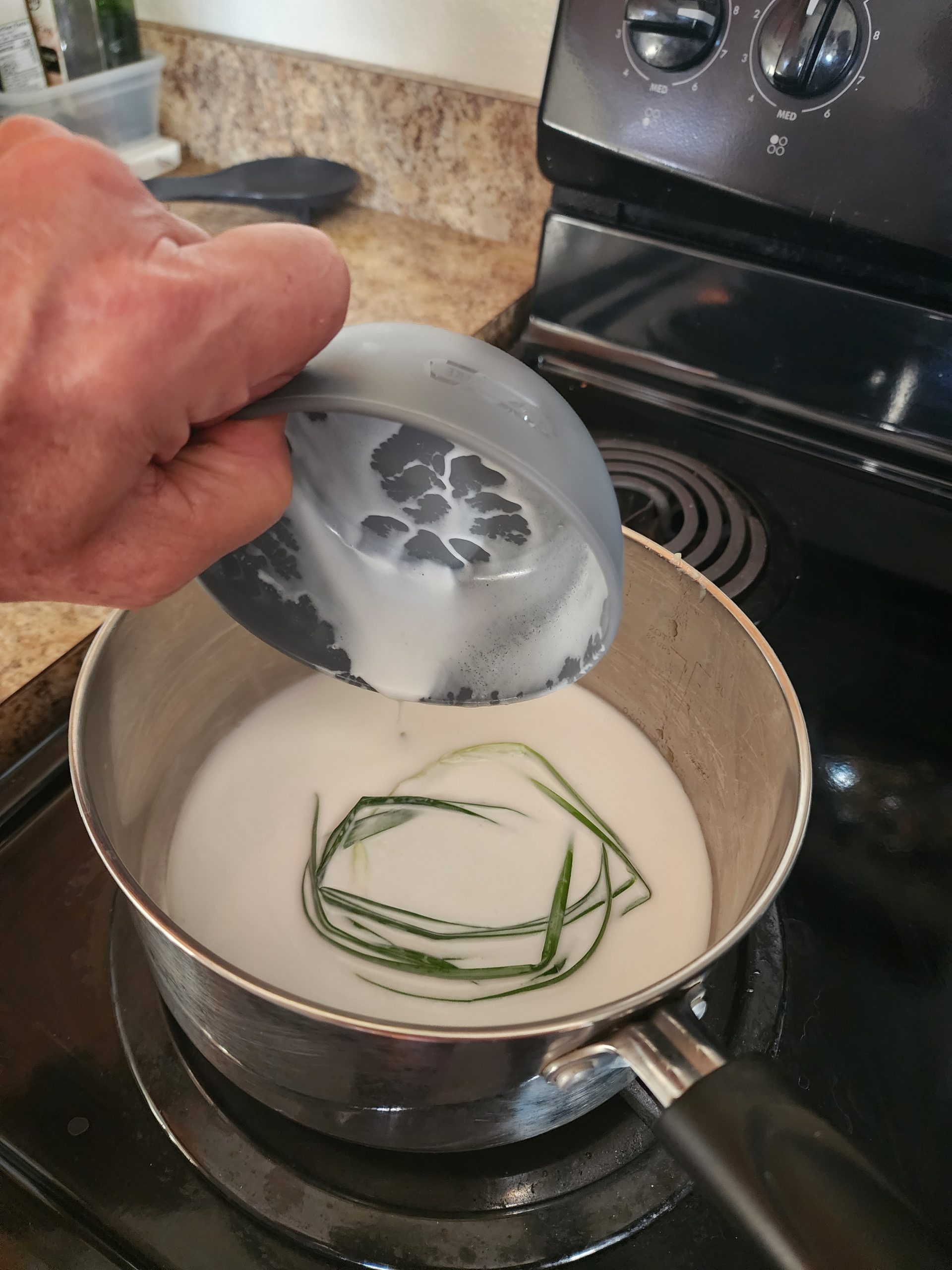
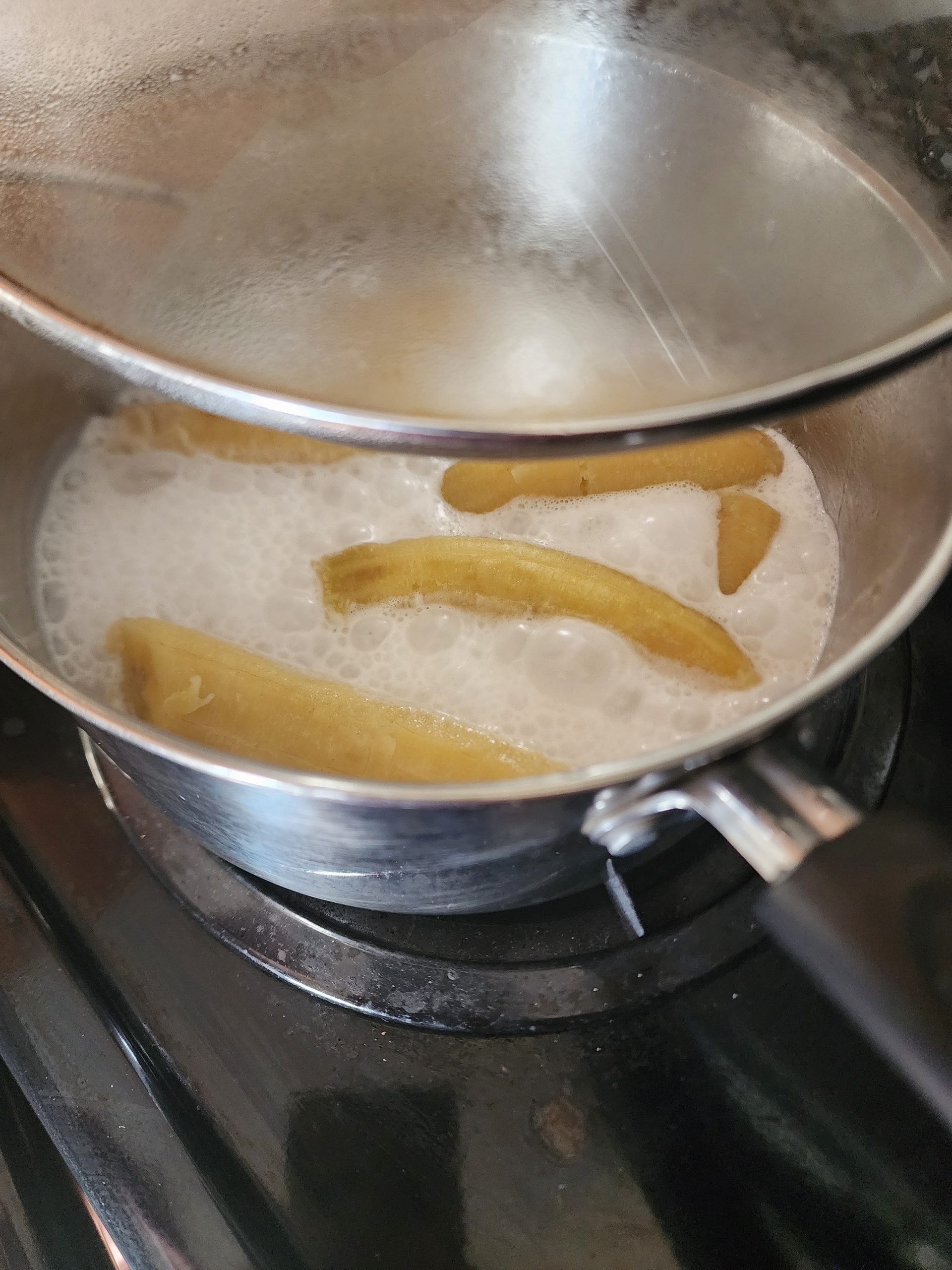
This shows a half recipe made with 4 bananas. Yours will be twice as large.
How done is done?
Here is where we diverge in our recipe. The traditional cooking time is about 5 minutes. We went for 8 minutes (forgive me, my Polynesian friends). Samoans would say that they are now too mushy. We found them to be more the consistency of boiled potatoes. Plenty good, but not chewy.
It’s your choice, just don’t serve these mashable bananas to your Polynesian friends unless you like getting the Poly side-eye.
What you want to be sure to accomplish is to cook the coconut milk into a thick, creamy sauce. The higher the temperature of the burner, the faster that will happen. But like I warned earlier, you will need to keep an eye on it to make sure that you do not burn it. Conversely, overcooking happens quickly too, so pay close attention.
Ready to eat!
Place in a bowl and serve. Told you it was easy!
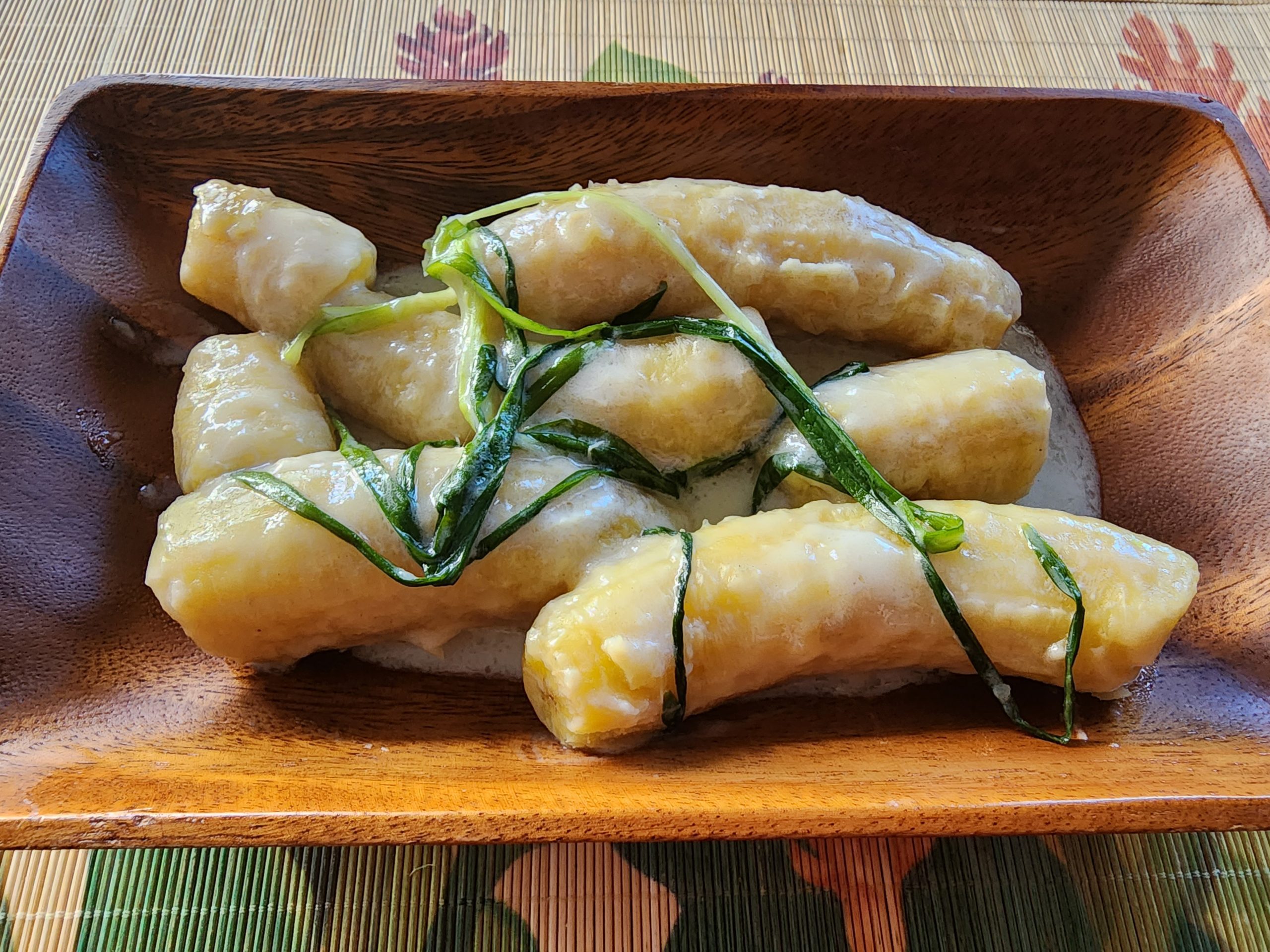
See how the creamy coconut sauce coats the bananas? That’s the goal!

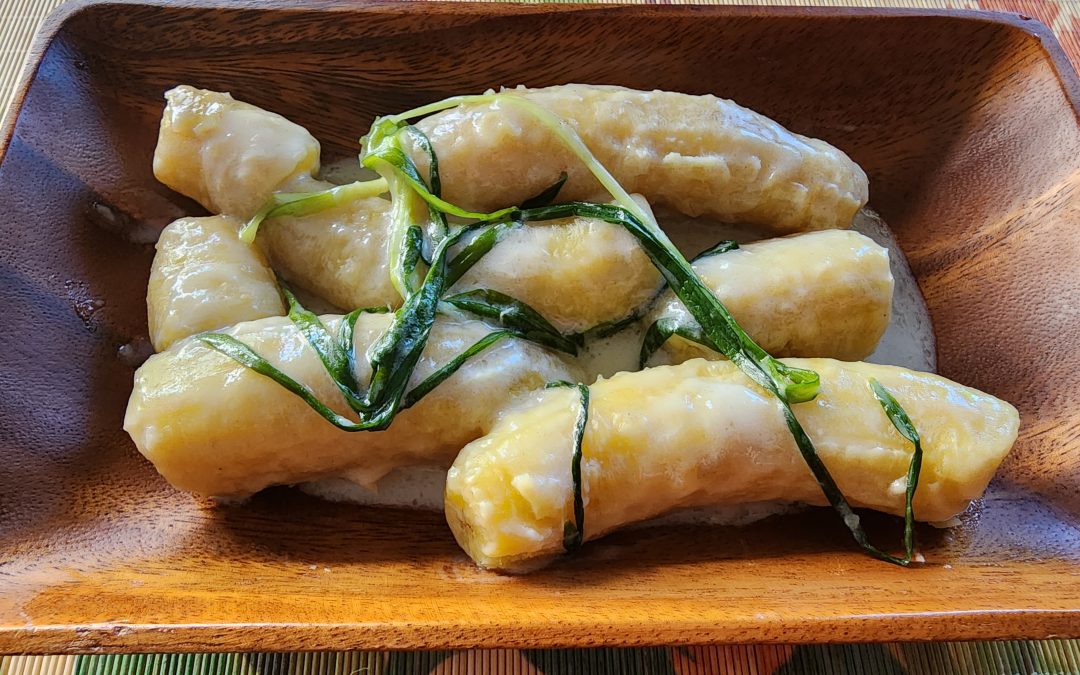
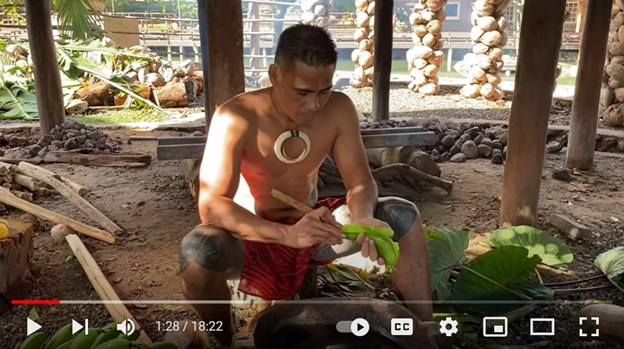
Recent Comments